|
Biographies
RENOIR : A ROMANTIC IMPRESSIONIST MASTER
|
Pierre-Auguste Renoir (1841-1919) began to work in a porcelain factory in Paris where he might have continued a modest career painting designs on chinaware had he not met some other talented painters such as Monet, Sisley and Bazille while studying in the studio of Gleyre in 1862. He worked with them in Barbizon and rapidly became a prominent figure of the Impressionist movement. Pierre-Auguste Renoir was born on February 25th 1841 in Limoges, central France. The sixth child of Léonard and Marguerite Renoir, he went with his family to Paris three years later. His father was a modest tailor and faced difficulties to earn a decent living while at 13, Pierre-August went to work as an apprentice in the Lévy Brothers firm which was producing hand-painted porcelains. He thus painted plates and showed such a talent as a painter that he was soon entrusted with the task of reproducing delicate scenes and portraits on porcelain pieces. At the same time he followed night courses to improve his drawing abilities. 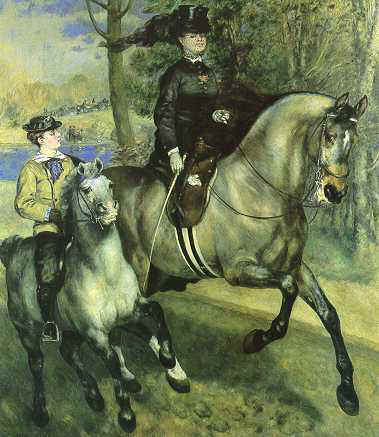
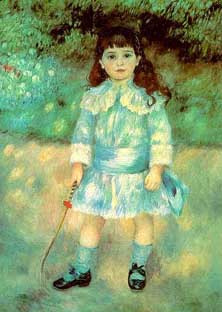 During the spring of 1858 the Lévy firm faced difficulties and Renoir lost his job. However he soon found another occupation with a painter of roller-blinds named Gilbert. He notably painted religious scenes on blinds that missionaries in African or Asian countries would hang in their makeshift churches. Working quite rapidly Renoir saved enough money to achieve the dream of becoming a true painter. In 1861 he was admitted at the School of Beaux Arts in Paris ranking 68th out of 80 lucky candidates. On April 1st 1862 he managed to become a pupil in the studios of Emile Signol and Charles Gleyre, a famous Swiss artist. Renoir worked there anonymously though in a somewhat diligent way. In the studio of Gleyre Renoir befriended three fellow-pupils, Claude Monet from le Havre, Frédéric Bazille from Montpellier and Alfred Sisley, an Englishman born in Paris. 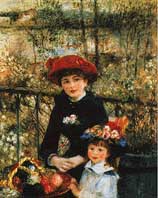
Despite their different origins and temperaments these four young artists got on well together and were to form the chore of a movement that was to cause deep changes in the history of painting. Renoir soon felt that Gleyre's teaching was going against his own idea of painting and decided to leave his studio with his friends in April 1863. They then went to produce paintings on the spot in the forest of Fontainebleau where Renoir met Narcisse Diaz and Gustave Courbet whom he much admired.
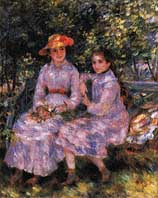 Renoir's first works were much influenced by Courbet's palette of colours and until the 1870 Franco-Prussian war he spent much time painting in the vicinity of Fontainebleau. He also met Jules Le Cœur who was living with his mistress Clémence Tréhot in Marlotte. Both were art collectors while Clémence second daughter, named Lise, became Renoir's model. Renoir painted over 20 portraits of Lise and represented her as Diana hunting, the woman with an umbrella in 1867, the Bohemian girl symbolising summer in 1868 or the Woman of Algiers in 1870. At that same time, Renoir was still traditional in his approach of painting though he professed his taste for clearer colours in 1867 and his use of blue tones hearlding his future Impressionist works. From 1867 to 1870 he shared Sisley's and Bazille's studios. He notably painted Bazille's portrait seating before his easel and wearing red slippers. Soon afterwards he met Edmond Maître, a dilettante and art collector from Bordeaux who made him acquainted with other artists such as Fantin-Latour or the photographer Carjat. The Impressionist artists often met in a beauty spot named la Grenouillère, which Renoir represented in his paintings around 1869. Renoir and Bazille also used to meet in the Café Guerbois, 11 Grande Rue des Batignolles. There they would have a drink with Edouard Manet, the writer Emile Zola, the draughtsman Constantin Guys, the painter Alfred Stevens and several art critics.
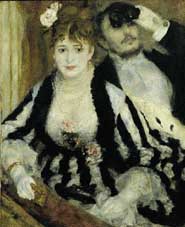 The 1870 Franco-Prussian war led Renoir to enlist in the French army and join a garrison in Libourne but he soon fell seriously ill. After he was discharged he returned to Paris in March 1871 and went back to work though he was quite affected by the death of Bazille who had been killed in fighting. The 1870 Franco-Prussian war led Renoir to enlist in the French army and join a garrison in Libourne but he soon fell seriously ill. After he was discharged he returned to Paris in March 1871 and went back to work though he was quite affected by the death of Bazille who had been killed in fighting.
In 1872 Renoir was lucky to meet the art dealer Paul Durand-Ruel to whom he was introduced by Pissarro and Monet. Durand-Ruel soon bought a painting from Renoir, « Le Pont des Arts et l'Institut » (Now in the Norton Simon collection in Los Angeles) and started to support him and his friends the best he could. At the 1872 Paris Salon Renoir met success with his « Parisian women dressed in Algerian attires » in which he showed Lise Tréhaut for the last time because she had just married a young architect and quickly decided to play the role of a good housewife instead. In fact she was to never see Renoir again after her marriage. 
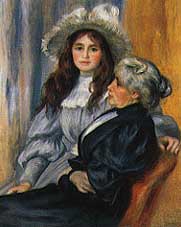 In September 1873 Renoir settled in Montmartre, 35 rue Saint-Georges. In September 1873 Renoir settled in Montmartre, 35 rue Saint-Georges.
He painted there two of his most famous works, «La Loge» (The Box) and the Woman dancer. Six months later he took part in the first exhibition of Impressionist artists at the Nadar Gallery, 35 Boulevard des Capucines but most people who came to see their works demonstrated their hostility to such a point that Renoir and his friends got laughed at in most circles. Still, he had managed to sell three paintings and a small dealer called Martin bought «La Loge» for 425 francs.
During these days Renoir often went to the Nouvelle Athènes café in Pigalle where independant painters used to meet. There he befriended Degas, Manet, Goeneutte and Frédéric Cordey. In order to solve dire financial problems Renoir persuaded Monet, Sisley and Berthe Morisot to sell their works at auction. The first sale took place in the Hotel Drouot salesrooms on March 24th 1875 but the public reacted violently and police had to intervene to disperse demonstrators. The sale was a disaster as Renoir sold 20 paintings for the ridiculous sum of 2 251 francs. Despite such failure, the sale had some benevolent effect for Renoir since he met Victor Choquet, a not very well known art collector who had come to Drouot during an exhibition of his paintings. Choquet had found that they had some resemblance with the works of Delacroix whom he considered as his god.
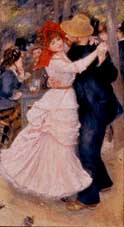 Choquet asked Renoir to paint the portrait of his wife and became rapidly one of his most enthusiastic supporters. In April 1875 the painter was paid 1200 Francs for a large painting called «La Promenade» (Now in the Frick Collection in New York) and could afford to rent a two room apartment and a former stable situated 12, Rue Cortot in Montmartre. Choquet asked Renoir to paint the portrait of his wife and became rapidly one of his most enthusiastic supporters. In April 1875 the painter was paid 1200 Francs for a large painting called «La Promenade» (Now in the Frick Collection in New York) and could afford to rent a two room apartment and a former stable situated 12, Rue Cortot in Montmartre. In the adjoining garden he painted some charming portraits of the actress Henriette Henriot, of a young model called Nini Lopez and of Claude Monet shown painting outdoors. During the Spring of 1876 Renoir started to produce some large paintings such as «La Tonnelle», «Nude under the Sun», «The Swing» and the «Moulin de la Galette». The bar of the «Moulin de la Galette» was situated on the Butte Montmartre hilltop at the corner of the Rue Lepic and many artists, students, workers and beautiful girls used to gather there during Sunday afternoons. Renoir painted the popular ball of the «Moulin de la Galette» showing his friends and models, notably the artists Goeneutte and Henri Gervex. This joyful painting representing a daily life scene was bought by Gustave Caillebotte and was exhibited in the third exhibition of the Impressionist painters. The art critic Georges Rivière notably hailed it as being a precious monument of Parisian life.
During the 1872-1882 years Renoir instilled more poetry and light effects in his works. He then used to juxtapose vivid and light touches on the canvas which would combine in the eye of the viewer while keeping their vibrating power. In September 1878 he visited Alphonse Daudet in Champrosay while his financial situation improved just after his meeting with Georges Charpentier, a publisher who had bought one of his paintings. Renoir was often the guest of the Charpentier couple and produced the portraits of their children. He notably needed some 40 posture sessions to paint the large portraits of Mrs Carpentier and of her two daughters with their dog (154 x 190cm, now in the Metropolitan Museum of New York). Thanks to Charpentier's influence, this work was exhibited in the 1879 Paris Salon and established Renoir's fame. Impressed by such success, Pissarro wrote in a letter sent to his friend Eugene Murer on May 27th 1879 that he thought that Renoir had definitely been brought out and that the years of misery were behind him. In 1880 Renoir met Aline Charigot, a milliner aged 20. She became his model and he produced a charming painting showing seated on grass with flowers in her hands and a small dog laying by. While in Chatou during the summer he decided to paint the Lunch of the Rowers in the Fournaise restaurant, which he completed in his studio during the winter. He then made the acquaintance of Georges Grimpel, a banker for whom he painted the portraits of his son and two daughters. Renoir received loads of orders but in February 1881 he became tired of Paris and decided to visit Algeria with his friend Frédéric Cordey. Much impressed by the North African atmosphere he painted the portraits of several Arab women as well as scenes. Back in Paris, he decided to visit Italy in October 1881 and stopped in Venice where he produced a series of paintings.
He then went to Florence, Rome and Naples where he expressed his anguish after seeing the works of Raphael in Rome. He then thought he had to learn more. In Capri he painted a marvellous Blonde Bather and decided to visit Sicily in January 1882. There he painted Richard Wagner's portrait. His trip to Italy had inspired him much especially as he had discovered the works of many Renaissance artists. Such discovery made him change his style as seen in The Umbrellas now in the National Gallery in London. He then developed a softer and more subtle brush stroke and turned away from contemporary themes to more timeless subjects, notably nudes and pictures of young girls.
In January 1882 he made a stop in Marseilles and stayed a fortnight during which he visited Cézanne but while painting outdoors he fell ill with a severe pneumonia. 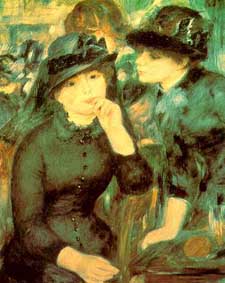 On his return to Paris he went on to live with Aline and resumed work producing again many portraits and a replica of his Blonde Bather which was sold by Durand-Ruel to Paul Gallimard. On his return to Paris he went on to live with Aline and resumed work producing again many portraits and a replica of his Blonde Bather which was sold by Durand-Ruel to Paul Gallimard.
Renoir fully established his reputation with a solo exhibition held at the Durand-Ruel Gallery in Paris in 1883. In 1887 he completed a series of studies of a group of nude female figures knwon as the Bathers now in the Philadelphia Museum of Art. These were unsurpassed in the history of modern painting in their representation of feminine grace. Renoir was then was noted for his radiant, intimate paintings, harmony of lines, the brilliance of his colour and recognized by the critics as one of the greatest and most independent artists of his time. Renoir was also much interested in painting the single human figure or family groups portraits as he was in landscapes Renoir became much influenced by Ingres during the 1883-1887 years after believing he had reached the limits of Impressionism and thinking he was deadlocked with the feeling that he still did not know how to draw or paint. After discovering antique sculptures In Naples and the frescoes of Pompei Renoir had faced some kind of deep crisis and felt it was a mistake to paint outdoors because of the problem of light. He stressed that he could not paint a model properly because of the movements of the sun and of clouds. For this reason he decided to study old masters and Ingres and turned his back on his previous productions. He then applied clear colours on his canvas like in his 1887 painting of the
« Grandes Baigneuses » (Big Bathers, 115 x 170 cm now in the Philadelphia Museum of Art) for which he had already done a much achieved study two years earlier and a freer version (115 x 168cm in the Masséna Museum of Nice) between 1885 and 1902.  Renoir went on to paint some mythological subjects while female types became more ample probably due to the fact that after 1890 he suffered a severe bout of arthritis which eventually left him crippled a few years with the result that he was forced to paint with a brush strapped to his arm. Renoir went on to paint some mythological subjects while female types became more ample probably due to the fact that after 1890 he suffered a severe bout of arthritis which eventually left him crippled a few years with the result that he was forced to paint with a brush strapped to his arm.
In the meantime, his touch had become more fluid, voluptuous and simpler. In the last quarter of 1883 Renoir rented a studio, 37 rue Laval (now rue Victor Massé) and a flat rue Houdon. On March 21st 1885 his wife Aline gave birth to their first son named Pierre and from then on the artist paid more attention to his family. As a bachelor Renoir had been somewhat always on the move. As a married man he had much steadied down eating at regular hours with his bed done, his shirt well ironed and a loving family around him.
Renoir had become a man with regular habits especially after his wife had given birth to a second son named Jean. He then painted many works showing women holding or even suckling a child, notably his wife and found more pleasure in representing his family on a canvas than with numerous orders. 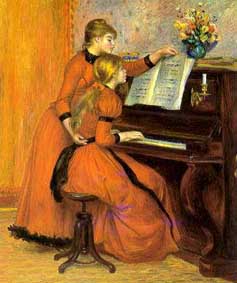 In April 1888, he painted the portraits of the daughters of the poet Catulle Mendès around a piano and found new customers through dealers or galleries like Georges Petit, Boussod and Valadon and Knoedler. In April 1888, he painted the portraits of the daughters of the poet Catulle Mendès around a piano and found new customers through dealers or galleries like Georges Petit, Boussod and Valadon and Knoedler.
After a period of intense activity Renoir felt at a loss again and destroyed several paintings. Ridding himself from the influence of Ingres he found his early style back with his «Période Nacrée» (Pearly lustred period) around 1889. In 1890 he often went to visit Berthe Morisot and her husband in Mézy and dedicated himself to painting nudes and portraits with a pearl lustre touch such as the Two Girls Picking Flowers (now in the Museum of Fine Arts, Boston) and in The Meadow (now in the Metropolitan Museum, New York).
Also most representative of this period were the various versions of Girls at a piano. Around 1900 Renoir then suffered bouts of arthritis but he managed to continue to paint. Thinking that the southern French climate was more appropriate for his health he settled in Cagnes in 1903. He then produced many landscapes seen from the window of his spacious apartment situated in a former Post Office building. Much happy with his wife, his three sons (Aline had given birth to Claude on August 4th 1901) and their servant Gabrielle who became his favourite model, Renoir used to work every day in his apartment or sometime outdoors. On June 28th 1907 he bought a charming property in the «Les Collettes» area and often worked in a garden surrounded by trees and flowers. Southern France had much in common with the atmosphere of Italy and Renoir came to paint scenes from the Greek antique period as he believed that the paradise of gods was the Earth itself.
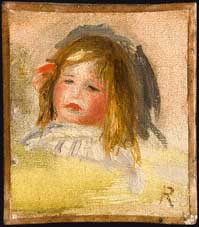 Renoir resuscitated old mythological legends like the Judgement of Pâris in 1908. Still he also painted the portraits of many friends though he preferred to represent young women like Gabrielle Renard, Madeleine Bruno, Hélène Bellon, Joséphine Gastaud or Andrée Hessling called «Dédé» who became Jean Renoir's first wife in 1920. Renoir resuscitated old mythological legends like the Judgement of Pâris in 1908. Still he also painted the portraits of many friends though he preferred to represent young women like Gabrielle Renard, Madeleine Bruno, Hélène Bellon, Joséphine Gastaud or Andrée Hessling called «Dédé» who became Jean Renoir's first wife in 1920.
Renoir, despite being affected by severe bouts of rhumatism, was then at his height like when he painted Gabrielle with her naked breasts in 1907 or a similar portrait with jewels in 1910. He had finally mastered the art of applying vibrant colours on the canvas in sticking to close reality.
However, despite being confined to a wheelchair from 1912, he continued to paint until the end of his life taking up sculpture in his late years with his assistant Richard Guino to act as his hands. 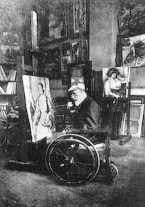 The outbreak of the First World War caused a rupture in his life. His two sons Pierre and Jean enlisted in the French army and were soon engaged in fighting in Eastern France. Both were seriously wounded and their anxious mother rushed to the hospital where they had been sent. Back in Cagnes she fell ill and Renoir rushed her to an hospital in Nice but she died on June 28th 1915. The outbreak of the First World War caused a rupture in his life. His two sons Pierre and Jean enlisted in the French army and were soon engaged in fighting in Eastern France. Both were seriously wounded and their anxious mother rushed to the hospital where they had been sent. Back in Cagnes she fell ill and Renoir rushed her to an hospital in Nice but she died on June 28th 1915.
Much affected by the death of his wife, Renoir's health progressively deteriorated. He returned to Paris and working with his brushes attached to his forearm and fingers, he produced his last paintings and was happy to see his portrait of Mrs Charpentier exhibited in the Louvre Museum. Renoir was given a warm reception in the Museum, which he visited in his wheel-chair while he was hailed as the «Pope of painting». Back in Cagnes, he resumed work but caught a cold while painting in his garden.
On December 1st 1919, after posing for the sculptor Marcel Gimond he had a chat with the dealer Ambroise Vollard and Felix Fénéon, adviser to the Bernheim Jeune Gallery. Then he felt feverish and weak after starting to paint a small still life of apples and was forced to lay down. He died at 2 a.m on December 3rd after asking for his palette to paint some woodcocks to which his doctor had referred to while at his bedside telling him that he had killed two such birds during a hunting party. «Give me my palette back... Turn the head of this woodcock to the left... I cannot paint this beak... Colours, quickly... Change the place of these woodcocks», were his last words. Renoir was among the most interesting Impressionist painters because of his subjects- children, flowers, beautiful scenes and nudes- and his desire to make art pretty. Today Renoir's paintings are rated between $ 20,000 for very small studies up to between $ 1 million and $ 82 millions (Le Moulin de la Galette) for major works.
Adrian Darmon
|
|